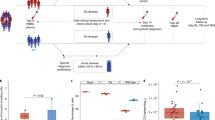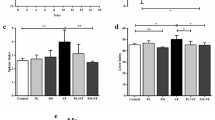Abstract
T-2 toxin and other trichothecene mycotoxins experimentally impair normal immune function and may predispose humans and animals to infectious disease. In this study, the histopathologic effects of Salmonella typhimurium challenge concurrently with sublethal T-2 toxin exposure were examined in the Salmonella-resistant C3H/HeN mouse. Oral administration of T-2 toxin (1 mg/kg) every other day for 10 d had little effect on the tissues examined when compared to control animals. Mice challenged with S. typhimurium and then treated with T-2 toxin every other day for 10 d had markedly larger and more bacterial-related lesions in the spleens, kidneys, and livers than animals challenged with S. typhimurium alone. Differences in bone marrow, Peyer's patches and ileal tissues were less discernable between S. typhimurium and S. typhimurium plus T-2 toxin treated groups. These results were consistent with previous findings that T-2 toxin compromised murine resistance to S. typhimurium infection and ultimately caused death in animals challenged with a sublethal dose of the organism.
Similar content being viewed by others
References
Bradley SG. Interactions between endotoxin and protein synthesis, pp. 340–371. In: LJ Berry (ed.), Handbook of Endotoxin, vol. 3, Cellular Biology of Endotoxin, Elsevier, Amsterdam, 1985.
Boonchuvit B, Hamilton PB & Burmeister HR. Interaction of T-2 toxin with Salmonella inflections of chickens. Poult Sci 1975; 54: 1693–1696.
Carter PB & Collins FM. The route of enteric infection in normal mice. J Exp Med 1974; 139: 1189–1203.
Corrier DE, Ziprin RL & Mollenhauer H. Modulation of cell-mediated resistance to Listeriosis in mice given T-2 toxin. Toxicol Appl Pharmacol 1987; 89: 323–331.
Giannella RA, Washington O, Geemski P & Formal SB. Invasion of Hela cells by Salmonella typhimurium: A model for study of invasion of Salmonella. J Infect Dis 1973; 128: 69–75.
Kanai K & Kondo E. Decreased resistance to mycobacterial infection in mice fed a trichothecene compound (T-2 toxin). Japan J Med Sci Biol 1984; 37: 97–104.
Lafarge-Frayssinet C, Lespinats G, Lafont P, Loisillier F, Mousset S, Rosenstein Y & Frayssinet C. Immunosuppressive effects of Fusarium extracts and trichothecenes: blastogenic response of murine splenic and thymic cells to mitogen. Proc Soc Exp Biol Med 1979; 160: 302–311.
McLaughlin CS, Vaughan MH, Campbell IM, Wei CM, Starford ME & Hansen BS. Inhibition of protein synthesis by trichothecenes. pp. 236–273. In: JV Rodricks, CW Hesseltine and MA Mehlman (eds). Mycotoxins in human and animal health. Proceedings of a conference on mycotoxins in human and animal health. University of Maryland. College Park, MD. Pathotox Publ, Park Forest, South, IL, 1977.
Morrison DC. Bacterial endotoxins and pathogenesis. Rev Infect Dis 1983; 5 (Suppl. 4): s733-s747.
O'Brein AD. Influence of host genes on resistance of inbred mice to lethal infection with Salmonella typhimurium. Curr Top Microbiol Immunol 1986; 124: 37–46.
Pathre SV & Mirocha CJ. Assay methods for trichothecenes and review of their natural occurrence, pp. 229–253. In: JV Rodricks, CM Hesseltine & MA Mehlman, (eds.) In: Mycotoxins in Human and Animal health. Proceedings of conference on Mycotoxins in Human and Animal Health, University of Maryland, College Park, MD. Pathotox Publishers, Park Forest South, IL, 1977.
Pestka JJ, Tai J-H, Witt MF, Dixon DE & Forsell JH. Suppression of immune response in the B6C3F1 mouse after dietary exposure to the Fusarium mycotoxins deoxynivalenol (vormitoxin) and zearalenone. Fd Chem Toxicol 1987; 25: 297–304.
Rosenstein Y, Lafarge-Frayssinet C, Lespinats G, Loisillier F, Lafont D & Frayssinet C. Immunosuppressive activity of Fusarium toxins, effects on antibody synthesis and skin grafts of crude extracts, T-2 toxin, and diacetoxyscirpenol. Immunology 1979; 36: 111–117.
Rosenstein Y, Kretschmer RR & Lafarge-Frayssinet C. Effect of Fusarium toxins, T-2 toxin and diacetoxyscirpenol on murine T-independent immune responses. Immunology 1981; 44: 555–560.
Rosentreich DL. Genetic control of endotoxin response, pp. 82–122. In: LJ Berry (ed.), Handbook of Endotoxin, vol. 3, Cellular biology of Endotoxin. Elsevier, Amsterdam, 1985.
Rubin RH & Weinstein L. Salmonellosis: microbiologic, pathologic and clinical features. Stratton International Medical Book Cooperation, New York, 1977.
Tai JH & Pestka JJ. Impaired murine resistance Salmonella typhimurium following oral exposure to the trichothecene T-2 toxin. Food Chem Toxicol 1988; 26: 691–698.
Tai JH & Pestka JJ. Synergistic interaction between the trichothecene T-2 toxin and Salmonella typhimurium lipopolysaccharide in C3H/HeN and C3H/HeJ mice. Tox Lett 1988; 44: 191–200.
Ueno Y. Mode of action of trichothecenes. Pure Appl Chem 1977; 49: 1737–1745.
Warren KSA. Functional classification of granulomatous inflammation. Ann NY Acad Sci 1976; 278: 7–18.
Wei RD, Strong FM, Smalley EB & Schnoes HK. Chemical interconversion of T-2 and HT-2 toxins and related compounds. Biochem Biophys Res Commun 1971; 45: 396–401.
Ziprin RL & McMurray DN. Differential effect of T-2 toxin on murine host resistance to three facultative intracellular bacterial pathogens: Listeria monocytogenes, Salmonella typhimurium and Mycobacterium bovis. Am J Vet Res 1988; 49: 1188–1192.
Author information
Authors and Affiliations
Rights and permissions
About this article
Cite this article
Tai, J.H., Pestka, J.J. T-2 toxin impairment of murine response to Salmonella typhimurium: a histopathologic assessment. Mycopathologia 109, 149–155 (1990). https://doi.org/10.1007/BF00436803
Received:
Accepted:
Issue Date:
DOI: https://doi.org/10.1007/BF00436803




